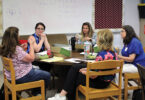
Students at Maur Hill-Mount Academy in Atchison bless the Benedictine Sisters of Atchison during an assembly on March 21 at the school. The Sisters are celebrating their 150th anniversary in the Archdiocese of Kansas City in Kansas with a year’s worth of celebrations.
by Joe Bollig
joe.bollig@theleaven.org
ATCHISON — A clear-eyed assessment at the time might have concluded that, perhaps, the seven Benedictine Sisters didn’t choose the best time to come here. And maybe they shouldn’t have come at all.
The Benedictines, however, walked by faith and not by sight, and so they came to Kansas.
They traveled hundreds of miles from Minnesota to Atchison by train and riverboat, while the country was at war, to establish a new foundation in a nine-year-old town that was literally on the edge of the frontier.
It was a different culture from what they knew. Atchison was nothing like the predominantly German Catholic communities they had formerly served.
The Benedictines crossed the Missouri River by ferry and landed at the Atchison wharf late on Nov. 11, 1863. There, the wharf master passed along the rumor that anti- Catholic thugs wanted to burn them out of their new home that night.
But they had friends in town, too. Benedictine monks established a priory here in 1857, and a school for boys. The lay carpenters from the priory built a sturdy, two-story brick home and school for the Sisters before their arrival, located at Second and Division streets.
That first night, the two carpenters doubled as sentries, patrolling the perimeter of the building with lanterns, keeping watch over the Sisters until dawn’s first light.
Not long after their arrival, the local newspaper published anonymous denunciations of the Sisters, prompting replies by someone called “Imprimatur.” At one point, the mayor and other prominent citizens were at the point of asking the Benedictine Sisters to leave town.
“[People’s opinions of the Sisters] were very mixed those first years,” said Sister Judith Sutera, OSB, director of communications and public relations for the Benedictine Sisters.
It was the Sisters’ actions that won the day.
“They won people over by simply showing the quality of what they were doing and by just being a presence,” she said. “They helped the poor and prayed every day. They were good neighbors.”
Of the first seven Sisters, only five stayed. It may not have looked like much at the time, but, from the perspective of the community’s 150-year anniversary, it’s clear now that the faith of those pioneering Benedictine Sisters has been vindicated.
They did indeed choose the right time and the right place. Their faith was not misplaced.
Living an ancient tradition
This is a time of celebration for the Benedictine Sisters of Mount St. Scholastica, which they call “With Grateful Hearts — 150 Years of Presence.”
Just one day wouldn’t be enough to express their gratitude to all those who have helped, supported and worked with them over the years. So, to celebrate the 150th anniversary of their founding, the Benedictine Sisters have scheduled a year’s worth of events, which began on Nov. 11, 2012, and will conclude on Nov. 17, 2013.
“We chose the theme of gratitude and ‘With Grateful Hearts’ because we’re so grateful for the blessings that we have, that are in our past and in our present, and it’s that gratitude that will take us into the future,” said Sister Ann Shepard, OSB, prioress since 2005.
“That’s why the schedule is so full,” she continued. “There are so many people for whom we are grateful — who have walked with us in our prayer, our ministry our community — our families and friends, and our donors.”
The logo of the sesquicentennial features a lantern, recalling those protective lanterns the priory carpenters carried that first night the Benedictine Sisters arrived.
The reason why the Benedictine Sisters came to Atchison was quite simple: to establish a new monastery and educate young girls.
They are, however, drawing on a very old tradition that can be traced back from the Atchison wharf to the convent at St. Cloud, Minn., founded in 1857; to the convent at St. Marys, Pa., founded in 1852; and even further back to St. Walburga Abbey in Eichstatt, Bavaria, founded in 1035.
It goes back even farther than St. Walburga, back nearly 1,500 years to St. Benedict himself and his monastery at Monte Cassino, in Italy.
While St. Benedict was the abbot of the men’s community at Monte Cassino, his sister St. Scholastica was leader of a women’s community five miles away at Plombariola. Thus, the two saints established a pattern of mutual support.
The Benedictine Sisters came to Atchison because the Benedictine men were here. Like at Monte Cassino and Plombariola, two Benedictine communities established separate but nearby foundations. The monks of St. Benedict Priory (later abbey) educated the boys, and the Sisters of Mount St. Scholastica educated the girls.
Faith and challenges
The history of the Benedictine Sisters of Mount St. Scholastica is dynamic — full of change. And it was never easy.
In the 1860s, the Benedictine Sisters’ immediate challenge was the establishment of their convent and school, and being accepted by the community. And keeping food on their own table, of course — the Sisters were desperately poor, using packing crates for furniture.
As the school grew, so did the monastery, even in face of hardship brought by the Panic of 1873 (a depression), which lasted until 1879. In her centennial history of the Benedictine Sisters, “The Meaning of the Mountain,” Sister Mary Faith Schuster, OSB, noted: “While the convent . . . never knew violence or starvation, it knew extreme poverty, over-crowdedness, and the work of daily sacrifice.”
Sister Mary Faith also records how a novice once asked why the founding prioress, Mother Evangelista Kremmeter (serving from 1863 to 1884) was crying. She was told, “Because there is not enough for the Sisters to eat.”
During those years, the prioress wrote many letters begging for assistance to donors throughout the United States and in Germany, including King Ludwig of Bavaria. Fortunately, the responses were generous.
The Benedictine Sisters took a big step forward when they established their first mission outside of Atchison, sending Sisters to live and teach in Seneca.
By the end of their first 100 years, the Benedictine Sisters would have educational missions in six states: 56 in Kansas, 20 in Missouri, 11 in Nebraska, nine in Iowa, 12 in Colorado, and 10 in California.
They also established “daughter” houses in Mexico City; Glendora, Calif.; and Colorado Springs, Colo. Today, the Benedictine Sisters have a dependent priory in Mineiros, Brazil.
The early years of the 20th century were a time of growth in the number of Sisters and in their educational ministries. The academy grew, and Mount St. Scholastica College was opened in the 1920s. In order to meet college accreditation standards, several of the teaching Sisters earned the first advanced degrees in the history of the monastery.
American society changed dramatically in the 20th century as it experienced two world wars and a decade-long economic depression. The Benedictine Sisters, never isolated from the larger society, were affected by it all. The last 50 years brought perhaps the greatest challenges and opportunities for the Benedictine Sisters, many arising from within the church itself, and the Second Vatican Council.
The latest 50 years
Benedictine prioress Sister Anne Shepard became a Benedictine Sister just at the close of the Second Vatican Council — an exciting time for both the universal church and the Atchison community.
Sister Anne, a native of Washington D.C., didn’t have any contact with the Benedictine Sisters before her arrival at Mount St. Scholastica College in 1963.
“When I came to Mount St. Scholastica, I said [to myself], if I’m going to join a community, this is the one I’m going to join,” she said.
“I loved the liturgies,” she continued. “The college Sisters were personable, bright and fun. And I thought, given the prayer and community, this would be the fit, even though it was a small town compared to Washington, D.C.”
The prioress at the time was Mother Mary Austin Schirmer, who served from 1966 to 1976.
“Mother Mary Austin led us through those years of renewal, keeping the community united and focused, and with a vision and charism that was a real gift to the community and the church at large in our area,” said Sister Anne.
These past 50 years have shown that the community has a great resilience and ability to change, said Sister Anne.
Changes at the college and the rural communities they had served, in particular, but also in the broader community, led to a re-visioning of the mission of the Sisters. Collectively, the Sisters had to answer an important question.
“How do we reshape our community when the campus no longer housed the major educational institutions of the college and the academy?” said Sister Anne.
“Those were major challenges for energy and creative use of resources,” she continued. And they required the input of a body of women who ranged from the youngest novice to those who had led those institutions for decades. But the challenges were eventually addressed, and the community forged ahead.
“We’ve come through this marvelously well, I think,” she said.
The dawn of the new century saw the Sisters beginning to turn their focus away from traditional education and to expand, instead, into a diverse range of ministries. At the same time, they’ve continued to be faithful to their core purpose.
“Our primary concern is prayer and community,” said Sister Judith. “The most important thing we do is prayer. We are not an apostolic community; we are a monastic community. We were not founded to do a particular work.”
So today, the Benedictine Sisters distinguish between a number of smaller programs and what they consider their sponsored ministries.
Their sponsored ministries, to which the community has some sort of formal commitment in terms of financial or personnel support, include Maur Hill/Mount Academy and Benedictine College in Atchison, Donnelly College and Keeler Women’s Center in Kansas City, Kan., and the Sophia Spirituality Center, Atchison.
But individual Sisters also work in ministries based on their own particular gifts and abilities. One Sister works as a doctor in a small hospital. Several others work in health care and social services. A number of Sisters give spiritual direction, while others teach at various levels of education.
The Sisters do all these things, however, in the same spirit that led them to come to Kansas so many years ago — in the spirit of Benedictine community, hospitality and prayer.
“The important things don’t change,” confirmed Sister Judith. “What matters is that the Benedictine life has been around for 1,500 years. This past 150 years has been a drop in the bucket.”
Keep calm and carry on
The milestone anniversary gives the Benedictine Sisters of Mount St. Scholastica a chance to celebrate their past.
But they’re looking forward to their future, too.
“We see the needs around us,” said Sister Judith. “We see the signs of the times. We see the struggles — whether it’s financial struggle or struggle in the church or the culture.
“We use a lot of creativity and determination. . . . And we continue to do what we do, to be relevant, and to find ways to help the people we need to help — and help ourselves keep going.”
That seems to be a part of the Benedictine tradition as well — that keep on keepin’ on.
“That’s part of our pioneer foundation,” Sister Judith concluded proudly. “It’s been part of the community’s culture from the arrival of the first Sisters.”
Yes, the Benedictine Sisters of Atchison still walk by faith, not by sight.
But they’ve found their path lit, down through the years, by lanterns held by the communities they’ve served.
There is, indeed, much to celebrate.






